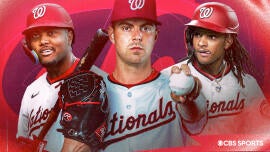
The 2025 Major League Baseball Draft gets underway on Sunday during All-Star Week festivities in suburban Atlanta, so it’s time for some last-minute cramming. We’ve been getting you amply prepared with rundowns of the top prospects and regular mock drafts, among other goodies, and now it’s time to address some the nuts and bolts of the draft. We speak of the signing-bonus slotting system that underpins the MLB Draft and shapes many of the decisions that teams make. At first blush, that system seems complicated and off-putting, but it’s not so hard to stand once you get into it. So let’s do just that — get into it with an explainer on how the MLB Draft works.
The Nationals have MLB Draft’s No. 1 pick and a new GM — is that enough to turn their rebuild around?
Dayn Perry

We’ll do this via the time-honored FAQ format …
So what is the slotting system?
The slotting system assigns specific dollar values to each draft position. These dollar values are in essence MLB’s “recommended” bonus amount for the player drafted at said position. These are not reflective of prevailing talent markets or tailored to each player’s estimated future value. Rather, they are arbitrary dollar figures, the purpose of which is to limit a draftee’s bargaining power and put a cap of sorts on the bonus he’ll command. Stated another way, it’s a means to limit labor costs, which is what team owners crave above all else.
What are the slot values for the 2025 draft?
Here are the assigned for values — i.e., the “recommended” bonus for the player drafted at each of these spots — for the first round of this year’s draft and the team that holds each respective pick (via MLB.com):
Pick No. 1: Nationals: $11,075,900
Pick No. 2: Angels: $10,252,700
Pick No. 3: Mariners: $9,504,400
Pick No. 4: Rockies: $8,770,900
Pick No. 5: Cardinals: $8,134,800
Pick No. 6: Pirates: $7,558,600
Pick No. 7: Marlins: $7,149,900
Pick No. 8: Blue Jays: $6,813,600
Pick No. 9: Reds: $6,513,800
Pick No. 10: White Sox: $6,238,400
Pick No. 11: Athletics: $5,985,100
Pick No. 12: Rangers: $5,746,800
Pick No. 13: Giants: $5,524,300
Pick No. 14: Rays: $5,313,100
Pick No. 15: Red Sox: $5,114,200
Pick No. 16: Twins: $4,929,600
Pick No. 17: Cubs: $4,750,800
Pick No. 18: Diamondbacks: $4,581,900
Pick No. 19: Orioles: $4,420,900
Pick No. 20: Brewers: $4,268,100
Pick No. 21: Astros: $4,122,500
Pick No. 22: Braves: $3,983,900
Pick No. 23: Royals: $3,852,100
Pick No. 24: Tigers: $3,726,300
Pick No. 25: Padres: $3,606,600
Pick No. 26: Phillies: $3,492,200
Pick No. 27: Guardians: $3,382,600
As you can see, the slot bonuses decline as we move down the draft order. That draft order is determined by lottery at the top end, and further down the order is determined by regular-season finish and then by postseason finish among the 12 teams that qualified for the playoffs.
Other wrinkles that affect draft order include whether a team is a revenue-sharing payor or payee, whether a team signed a qualifying-offer free agent, and whether a team is above the luxury-tax threshold on payrolls (and by how much and how many years in a row). This is why, you’ll note, the first round includes just 27 picks this year instead of, you know, one for each of MLB’s 30 teams. On that point …
What’s this about the luxury tax and draft order?
The luxury tax is officially and misleadingly known as the Competitive Balance Tax (CBT) on major-league payrolls and, like the slotting system, its purpose is to put artificial limits on how much teams can pay players. If a club’s CBT payroll, which is determined by calculating the average annual value of the contracts of all players on the 40-man roster, exceeds the CBT limit then penalties follow. The most notable of these involves paying various levels of taxes on the money they spend in excess of the CBT threshold, which for 2024 was set at $237 million. These penalties compound based on how far above the CBT threshold the team is and how much of a “repeat offender” they are.
For those well over the CBT line, there’s also a draft-related sanction. Here’s how the league explains it:
“Clubs that are $40 million or more above the threshold shall have their highest selection in the next Rule 4 Draft moved back 10 places unless the pick falls in the top six. In that case, the team will have its second-highest selection moved back 10 places instead.”
(Aside: The Rule 4 Draft is the solemn and bureaucratic official name of what regular folks call the MLB Draft.) So that explains why the Dodgers, Mets, and Yankees saw their first-round picks slide 10 spots and thus out of the first round. That means not only that theoretically more modest talents will be available to them at those lower slots, but it also means less total 2025 draft bonus money for these three clubs. Now let’s pose a question that gets us into that aspect of things.
So teams can’t pay a draftee more than his assigned slot value?
Not necessarily. A team’s draft budget is determined by what’s called its bonus pool, which is the sum of the assigned slot values for all its picks. Yes, every pick in the first 10 rounds of the draft is assigned a dollar figure. For picks after the 10th round, a team this year can pay those draftees more modest bonuses without having it count against their total pool. That also applies to undrafted free agents.
As you have probably already figured out, the higher a team picks and the more picks it has, the higher its bonus pool. That brings us to this year’s bonus pools for each of the 30 clubs (via MLB.com):
Mariners: $17,074,400
Rays: $16,699,400
Angels: $16,656,400
Nationals: $16,597,800
Orioles: $16,513,100
Rockies: $15,723,400
Marlins: $15,187,400
Cardinals: $14,238,300
Pirates: $14,088,400
Brewers: $13,138,100
Royals: $12,794,700
Twins: $12,653,000
Red Sox: $12,409,300
White Sox: $12,169,100
Reds: $11,836,800
Rangers: $10,991,300
Tigers: $10,990,800
Diamondbacks: $10,917,800
Athletics: $10,563,500
Blue Jays: $10,314,600
Guardians: $10,198,100
Cubs: $9,636,800
Braves: $9,081,100
Dodgers: $9,031,300
Giants: $8,403,300
Phillies: $7,849,400
Astros: $7,181,500
Padres: $6,569,100
Mets: $5,465,900
Yankees: $5,383,600
Can a team pay a draftee less than his assigned slot value?
Yes. We’ll get to this soon in terms of pool manipulation, but again, the assigned value is intended to serve merely as a suggestion. If a team can convince a player to take less than that number, they get to chalk that up as a win. We won’t pretend to guess why a player would agree to that, but it does happen. The main restriction is that if the player in question attended the MLB Combine and submitted to a medical as part of the event, he must be offered at least 75% of his slot value.
Are teams allowed to exceed their bonus pools?
Teams may do so, but it costs them. MLB.com explains:
“A team that exceeds its bonus pool faces a penalty. A club outspending its allotment by 0-5 percent pays a 75% tax on the overage. At higher thresholds, a team loses future picks: a first-rounder and a 75% tax for surpassing its pool by more than 5 and up to 10 percent; a first- and a second-rounder and a 100% tax for more than 10 and up to 15 percent; and two first-rounders and a 100% tax for more than 15%.”
The penalties get much steeper at more than a 5% overage, which is why no team has ever ventured into that fell territory. Getting into that first penalty phase, however, is a regular occurrence.
Clubs also do a lot of maneuvering within their bonus pools in order to make the numbers work and stay out of those deep penalty phases. Particularly at the front end of the draft, teams will sign players for less than their assigned slot bonus, which is known as signing “under slot.” Those savings can be applied later to sign a player to an “over slot” bonus that’s in excess of the assigned figure. For example, if the Nationals sign their No. 1 pick for less than $11,075,900, they can redistribute those savings to a pick in a later round and sign him “above slot.”
All of this allows teams on occasion to land players whom they deem to have more potential than their eventual draft position suggests. It’s all strategy-driven, and the groundwork for making the bonus pool work is laid long before the names are announced on draft day.
Can teams trade picks?
Not directly, no. There is, however, a small and not frequently wielded exception. Almost all draft picks cannot be traded. The exception is a small subset of selections known as competitive balance draft picks. The ten teams with the lowest annual revenues and the teams from MLB’s smallest markets (there’s obviously some overlap there) are eligible for such picks. Those picks can be traded, and when they are, the slot values go with them, thus increasing the acquiring team’s pool and reducing the trading team’s pool. This year, for example, the Orioles traded reliever Bryan Baker to the Rays for the 37th pick in the draft.
What happens if a drafted player doesn’t sign?
If players drafted within the first 10 rounds aren’t signed by the deadline, which is typically two weeks or so after the draft, then their slot money is subtracted from the team’s total bonus pool. That, in turn, could foul up a team’s “pool management” strategy and put them in penalty territory. Removing that slot value of unsigned players prevents teams from intentionally drafting players they will not sign and using their slot money elsewhere in the draft. The unsigned player can then go back into the draft the following year if he so chooses. The team, meanwhile, earns a compensatory pick for next year’s draft if the player was drafted in the first three rounds. The position of that pick is dependent on the draft position of the unsigned player.
Anything else?
No.
This news was originally published on this post .






Be the first to leave a comment